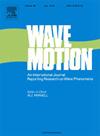A closed form expression for the resonance frequencies of an unbaffled simply-supported rectangular water-loaded plate
IF 2.1
3区 物理与天体物理
Q2 ACOUSTICS
引用次数: 0
Abstract
The sound radiation from a finite, simply-supported rectangular unbaffled plate submerged and vibrating in water is considered. The objective is to obtain a closed form expression for the coupled resonance frequencies of this water-loaded plate. The sound pressure at an arbitrary point in the surrounding fluid medium is expressed as an integral of the product of the pressure jump and the derivative of the Green’s function over the plate surface. Using Euler’s equation in the plane of the plate, a linear system of equations is obtained for the displacement field. The solution procedure involves a certain parameter known as the modal coupling coefficient. This coupling coefficient differs from that of the analogous problem of sound radiation by a baffled plate in that a square root term appears in the numerator. The improper double integral in the coupling coefficient is approximated analytically using the contour integration technique. It is in the nature of panel radiation that due to water loading, several types of modal interactions happen depending upon the frequency of excitation. For underwater applications, keeping 10 kHz as the upper limit of the excitation frequency, approximate analytical expressions for the modal coupling coefficient are derived specifically for the corner–corner and the edge–edge type interactions. Next, a small fluid loading parameter is introduced into the coupled equation of motion for the free vibration problem through the residual contribution of the coupling coefficient. Then, the perturbation method is used to obtain the closed form expression for the coupled resonance frequencies. Using this closed form expression, the coupled natural frequencies are computed for a standard size panel and compared with those obtained from the numerical calculations. A good match is observed between the two results. Along the way, a concerted effort is made to provide bounds on the error in the modal coupling coefficient caused by the various approximations. The closed form natural frequency expression is valid for a range of panel sizes, aspect ratios and thicknesses.
无挡板简支矩形水板共振频率的封闭表达式
考虑了有限简支矩形板在水中振动时的声辐射问题。目的是获得该水加载板的耦合共振频率的封闭形式表达式。在周围流体介质中任意一点处的声压表示为压力跳变积与平板表面上格林函数导数的积分。利用平板平面上的欧拉方程,得到了位移场的线性方程组。求解过程涉及到称为模态耦合系数的某个参数。这种耦合系数不同于类似的挡板声辐射问题,因为分子上出现了平方根项。利用轮廓积分技术对耦合系数中的不当二重积分进行了解析逼近。板辐射的本质是由于水的加载,根据激励频率的不同,会发生几种类型的模态相互作用。在水下应用中,保持激励频率上限为10 kHz,针对角-角和边-边型相互作用,导出了模态耦合系数的近似解析表达式。其次,通过耦合系数的剩余贡献,将一个小的流体加载参数引入到自由振动问题的耦合运动方程中。然后,采用摄动法得到耦合谐振频率的封闭形式表达式。利用该封闭表达式计算了标准尺寸面板的耦合固有频率,并与数值计算结果进行了比较。在两个结果之间观察到很好的匹配。在此过程中,共同努力提供了由各种近似引起的模态耦合系数误差的界限。封闭形式的固有频率表达式适用于各种面板尺寸、纵横比和厚度。
本文章由计算机程序翻译,如有差异,请以英文原文为准。
求助全文
约1分钟内获得全文
求助全文
来源期刊

Wave Motion
物理-力学
CiteScore
4.10
自引率
8.30%
发文量
118
审稿时长
3 months
期刊介绍:
Wave Motion is devoted to the cross fertilization of ideas, and to stimulating interaction between workers in various research areas in which wave propagation phenomena play a dominant role. The description and analysis of wave propagation phenomena provides a unifying thread connecting diverse areas of engineering and the physical sciences such as acoustics, optics, geophysics, seismology, electromagnetic theory, solid and fluid mechanics.
The journal publishes papers on analytical, numerical and experimental methods. Papers that address fundamentally new topics in wave phenomena or develop wave propagation methods for solving direct and inverse problems are of interest to the journal.
 求助内容:
求助内容: 应助结果提醒方式:
应助结果提醒方式:


